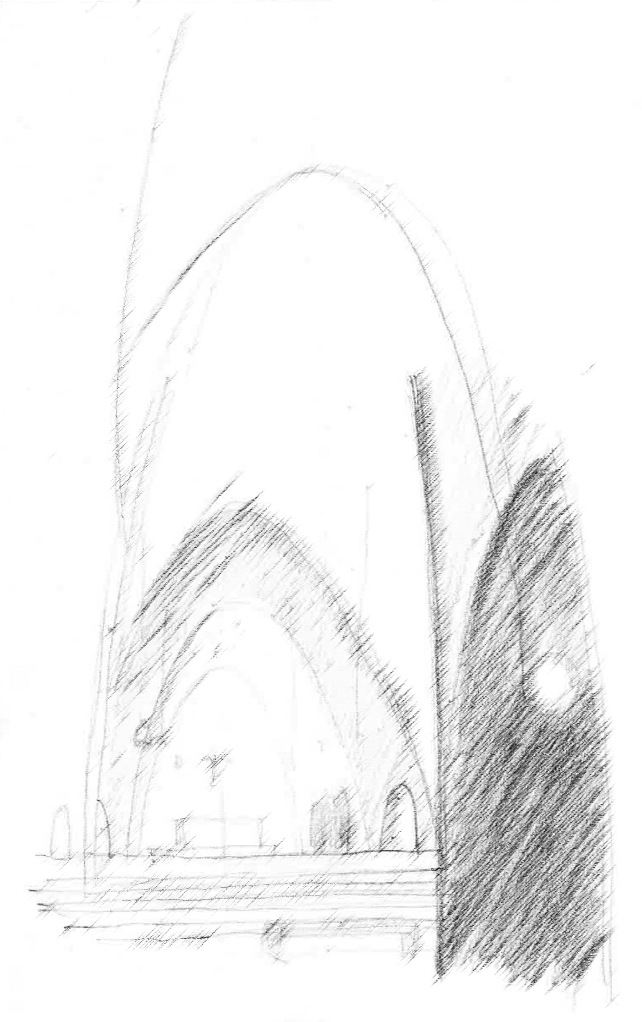Church of St Engelbert by Dominikus Böhm
By the end of 1920s Dominikus Böhm was already well known as a fine architect of ecclesiastical buildings and a keen promoter of the ideas spread by the Liturgical Movement. The design of St. Engelbert at Köln-Riehl however is Böhm’s most daring ecclesiastical work which at the time met with strong opposition from the church authorities. It embodies through the centralised plan and the simplicity of its interior, key architectural changes which would influence many future ecclesiastical buildings.
Built between 1930 and 1932, St Engelbert is a construction consisting of eight parabolic walls surmounted by barrel vaults made of red brick and concrete, covered with zinc and arranged in a circular pattern. On the approach it has the appearance of a giant alien-like structure, an object totally distinct from the surroundings through its shear form and proportions. Not much would announce it as a house of God apart from the tall freestanding campanile next to it which gives a slight hint of the purpose of the complex. But coming closer to the building, one can notice a slight outward curving of the great parabolic arch forming the main facade, giving the impression of a maternal womb or a tabernacle. Compositionally, the front elevation is remarkably sober and stark: the plain brick wall is punctured by a circular window (a severely stripped down version of the highly adorned medieval rose windows) under the apex of the arch, and three simple metal doors framed by white stone.
After climbing a number of steps and coming through the main entrance, one becomes absorbed by the almost scenic play of light and darkness enveloping the simple yet mysterious space. A large bright choir window bathes the altar in radiant light, making it in the focal point of the interior. By contrast, the central space is dimly lit by small round windows placed high up, drawing a clear distinction between altar and the main body of the church. These carefully calculated lighting conditions give a unique atmosphere to the lofty space of the nave.
Church of St Engelbert by Dominikus Böhm – altar and choir window
The circular plan of the church marks a return to the Early Christian church archetype. Here however the circle represents not only the Divine perfection and the unity of the Church but becomes also a contemporary expression of a ‘democratic’ church which places emphasis on community, corporate action and equality as opposed to traditional ecclesiastical hierarchy. The circle could also symbolise a desire to return to secular participation in the rites of transcendency.
Church of St Engelbert by Dominikus Böhm – plan
Through this simple yet significant change in plan, the clergy and the laity are encouraged to have a more direct relationship with one another during worship while the spacial relationship between choir and congregation brings the altar closer to the faithful. A certain distinction between the nave and the chancel is maintained however through the use of a set of marble steps. To the rear, the round plan is expanded by a rectangular wing accommodating the choir, the sacristy and the communal rooms.
Church of St Engelbert by Dominikus Böhm – altar
The design features minimal adornment, a neutral and dark interior with a continuos surface of white plastering lacking any special definition aside from the ribs. This simplicity gives a distinct beauty to the internal space and invites to quietness, peace and retreat.
While fully embracing the recent changes brought in ecclesiastical architecture by the Liturgical Movement, the Church of St. Engelbert in Riehl could still be seen as a wonderful interpretation of the medieval church architecture through its elaborate structure, lighting condition and space.
Bibliography
1. Heathcote, E., Moffatt, L. (2007). Contemporary church architecture. Chichester: Wiley-Academy.
2. Stock, W.J. (2006). Europaischer Kirchenbau/ European church architecture 1900-1950: Aufbruch Zur Moderne/ Towards modernity. Munich: Prestel Verlag GmbH & Co KG.
Note: Sketches by author.





I like very much the sketches!
Thank you, Mihaela, I hope to post more of them 🙂
[…] filled with approximately 1200 multicoloured glass pieces and resembles the window he designed for St. Engelbert. An understated sandstone portal frame marks the main entrance flanked by two smaller […]
[…] Article en anglais […]